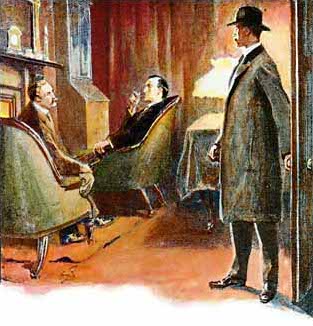

With the help of Theresa, they decided to make up a story to conceal the manslaughter. Crocker fought to stop him and unintentionally killed him. He decided to go to the Abbey Grange to comfort her, but Sir Eustace caught them and attempted to beat his wife. He's in love with Lady Mary, and had recently seen Theresa, who told him about her mistress's miserable fate. He summons then an officer named Jack Crocker, who finally admits he's guilty for the murder. Holmes and Watson return to London and visit the shipping office of the Adelaide-Southampton line, to get information about the crew that had travelled from Australia to England with Lady Mary. Holmes is puzzled by some facts that don't fit with the story - the knots around Lady Mary's wrists were nautical, and only one of the wineglasses has beeswing in it - and comes to the conclusion that the two women lied, but they stick to their version. Holmes also has a chat with Theresa, Lady Brackenstall maid since childhood, who tells she didn't hear anything until her mistress screamed. Her testimony suggests that the burglary is the work of the Randalls, a gang of burglars known to have been operating in the region lately. They took few pieces of silverware and each drank a glass of wine before they ran away.

She tells him that three men broke into the house as she entered the dining room and tied and gagged her, and that they killed Sir Eustace with a poker blow when he came, alerted by the noise. Holmes interviews Lady Mary Brackenstall, a young Australian who has been unhappily married to Sir Eustace, who was a drunkard and an abusive husband, for the past year. It appears that during a burglary, Sir Eustace Brackenstall had been killed by a blow to the head. On a winter morning, Holmes and Watson go off to Abbey Grange, in Kent in response to a request for help from Inspector Stanley Hopkins. « Vox populi, vox Dei » - Sherlock Holmes.23 january 1897 ( William Stuart Baring-Gould).Illustrations by Sidney Paget in The Strand Magazine (september 1904).in The World, New York, Fiction Magazine (25 june 1911 ).in Boston Sunday Post (25 june 1911 supplement ) as Masterpieces of Sherlock Holmes No.in Les Premiers exploits de Sherlock Holmes (1909, Félix Juven ) as L'Abbaye de Grange, 4 ill.in L'Abbaye de Grange (1906, Société d'Édition et de Publications Collection Rouge No.in Le Journal (21-25 august 1905 ) as L'Aventure de l'abbaye de Grange.in Owensboro Inquirer (3-6 july 1905 ) 1+ ill.in The Los Angeles Times (30 april 1905 ).in The Return of Sherlock Holmes (1905-1930).in Collier's (31 september 1904 ) 6 ill.in The Strand Magazine (september 1904 ) 8 illustrations by Sidney Paget.


 0 kommentar(er)
0 kommentar(er)
